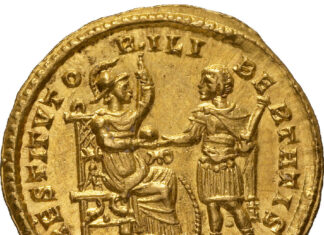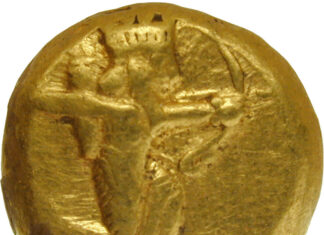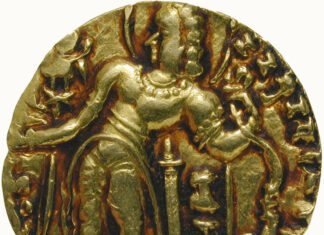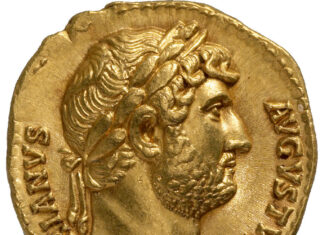Archives
Numismatic Puzzle: Knife Money
Commodity money including various tools had a long tradition in China. Knife money circulated for centuries, especially in northern China. This specimen from the Qi Kingdom dates to the 4th century BC.
Numismatic Puzzle: A New Capital for the Roman People
Today’s puzzle shows us how the Roman Empire moved its centre of power around 300: on this solidus, Roma presents the globe to Emperor Constantine the Great. From then on, it was no longer the old lady on the Tiber who played first fiddle but the metropolis on the Bosporus.
Numismatic Puzzle: Darius
Today you will see the Persian King Darius the Great (ca. 522-486 B.C.) in a half-kneeling stance as brave archer on one of his gold coins. For a long time, these darics, which were named after him, were a popular means of payment throughout the Mediterranean world.
Numismatic Puzzle: Kushan the Sasanidian Way
This gold coin comes from the Empire of Kushan in Northern India. But it resembles Sasanian coins because – when it was struck in the middle of the 4th c. AD – the Sasanians had conquered the Kushan empire at that time.
Numismatic Puzzle: Cunobelinus
For many collectors, Greek coins form the highlight of numismatics. Already the Celts of Britain were enchanted by these coins. A gold stater of Cunobelinus from the 1st century BC was inspired by coins of Alexander the Great.
Numismatic Puzzle: Spade Coin
No, today’s issue does not feature gardening tools, but a numismatic object lesser known in Europe. Spade coins were a type of money in ancient China. This coin is from the 3rd century BC and you can probably tell straight away how it got its name.
Numismatic Puzzle: Chandragupta II
Northern India experienced a period of prosperity around 400 under the Gupta dynasty. King Chandragupta II not only promoted arts and culture, he was also called the “world conqueror”. With bow and arrow, Chandragupta shows his martial side on this golden dinar.
Numismatic Puzzle: Hadrian’s Beard
Well-shaved or with beard? It’s always a statement – and it even was in ancient Rome. Hadrian was the first emperor with beard. Why? Scholars are still trying to figure out the answer. The beard certainly added a whole new “touch” to his coins as this aureus shows.
Numismatic Puzzle: Vespasianus
Vespasianus had to balance the budget – and created a tax for using public urinals. Smelling at the coins, the pragmatist stated: “It does not stink!“ Neither does this denarius. But you can look directly into the face of the cunning politician that Vespasianus was!
Numismatic Puzzle: Roman Denarius
Today you will deal with a Roman denarius and put the head of Roma together. The personification of the Roman people on this 141 BC silver coin has a proud glare, but the special feature of this specimen is something completely different.












